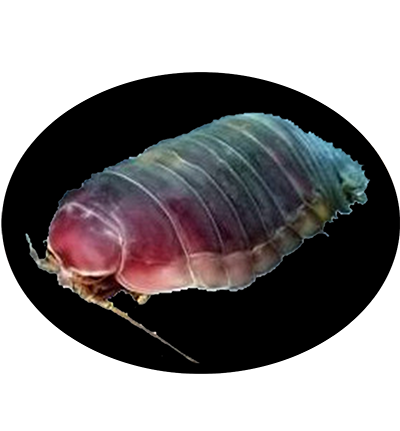
Bathynomus jamesi is widely distributed across different environments including the deep-sea and as such are a useful model for studying adaptation, migration, and speciation. They have larger body size than their shallow water relatives and have large stomachs and fat bodies presumably to store organic reserves. To adapt to the benthic environment, they adopt a burrowing behavior . They have developed an oversized stomach, which can take approximately 2/3 of the whole body cavity when it fills up with food. In addition, they are well known for their extremely long fasting state, which should be the longest record to date. Larger animals usually have greater absolute energy requirements.
Animalia (Kingdom); Arthropoda (Phylum); Crustacea (Subphylum); Multicrustacea (Superclass); Malacostraca (Class); Eumalacostraca (Subclass); Peracarida (Superorder); Isopoda (Order); Cymothoida (Suborder); Cymothooidea (Superfamily); Cirolanidae (Family); Bathynomus (Genus); Bathynomus jamesi (Species)
Bathynomus jamesi Kou, Chen & Li in Kou, Q., Chen, J., Li, X., He, L. & Wang, Y., 2017
1. Kou Q, Chen J, Li X, et al. New species of the giant deep‐sea isopod genus Bathynomus (Crustacea, Isopoda, Cirolanidae) from Hainan Island, South China Sea[J]. Integrative zoology, 2017, 12(4): 283-291. (Kou et al., 2017)
2. Huang M C, Kawai T, Bruce N L. A new species of Bathynomus Milne-Edwards, 1879 (Isopoda: Cirolanidae) from the southern Gulf of Mexico with a redescription of Bathynomus jamesi Kou, Chen and Li, 2017 from off Pratas Island, Taiwan[J]. Journal of Natural History, 2022, 56(13-16): 885-921. (Huang et al., 2022)
Holotype, 1 immature female (to-tal length [TL] 114 mm). Pleotelson with 11 or 13 short, straightspines; central spine not bifid. Uropod with endopodand exopod distolateral corner slightly produced. Cly-peus lateral margins concave, narrowly rounded apical-ly. Antennal flagellum extending to within pereonite 3. Body suboval, total length(114 mm) approximately 2.2 times as long as maximalwidth (53 mm)
The species is named after Dr James K.Lowry in recognition of his great contribution to thecrustacean taxonomy
Gulf of Aden, north-western IndianOcean and northern South China Sea, western PacificOcean at a depth of 563–898 m
| Species | Phylum | Common Name | Ecosystem | Depth | Habitat | NCBI Taxonomy ID |
|---|---|---|---|---|---|---|
| Bathynomus jamesi | Arthropoda | - | Hydrothermal vent | 898 | near Hainan Island, in the northern South China Sea (17° 46.845′ N, 110° 38.217′ E) | 1955234 |
| Genome Assembly | Genome Size | Assembly level | Released year | WGS accession | Submitter | BioProject | BUSCO completeness (%) | Scaffold/Contig N50 (kb) | GC content (%) | Repeat Rate (%) | Gene Number |
|---|---|---|---|---|---|---|---|---|---|---|---|
| ASM2301448v1 | 5.89Gb | Contig | 2022 | JAJOZX01 | Institute of Oceanology, Chinese Academy of Sciences | PRJNA776076 | 94.80 | 586.5 | 37.28 | 85.32 | 23,221 |
| Title | Journal | Pubmed ID |
|---|---|---|
| Genome of a giant isopod, Bathynomus jamesi, provides insights into body size evolution and adaptation to deep-sea environment | BMC Biology | 35562825 |
| Gene ID | Description |
|---|---|
| mRNA.BJAM.scaffold1329.7545 | - |
| mRNA.BJAM.scaffold1329.7546 | - |
| mRNA.BJAM.scaffold1329.7547 | CXC DOMAIN-CONTAINING PROTEIN-RELATED |
| mRNA.BJAM.scaffold1329.7548 | - |
| mRNA.BJAM.scaffold13290.22569 | - |
| mRNA.BJAM.scaffold13290.22570 | - |
| mRNA.BJAM.scaffold13293.22571 | - |
| mRNA.BJAM.scaffold13299.22572 | ELONGATION FACTOR 1 ALPHA |
| mRNA.BJAM.scaffold133.1056 | - |
| mRNA.BJAM.scaffold133.1057 | - |
| mRNA.BJAM.scaffold13303.22573 | - |
| mRNA.BJAM.scaffold13304.22574 | NUCLEAR HORMONE RECEPTOR |
| mRNA.BJAM.scaffold13309.22575 | - |
| mRNA.BJAM.scaffold1331.7549 | DEOXYNUCLEOSIDE TRIPHOSPHATE TRIPHOSPHOHYDROLASE |
| mRNA.BJAM.scaffold1331.7550 | - |
| mRNA.BJAM.scaffold13312.22576 | - |
| mRNA.BJAM.scaffold1332.7551 | - |
| mRNA.BJAM.scaffold13321.22577 | - |
| mRNA.BJAM.scaffold13322.22578 | - |
| mRNA.BJAM.scaffold13322.22579 | RIBOSOMAL PROTEIN S6 KINASE |

